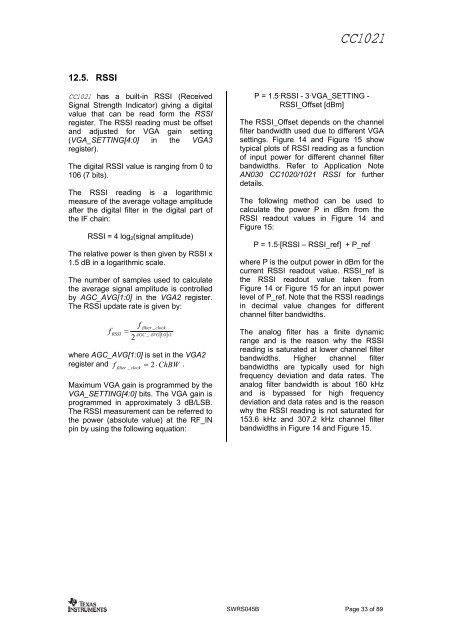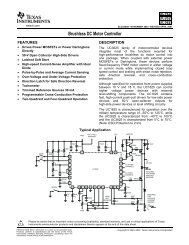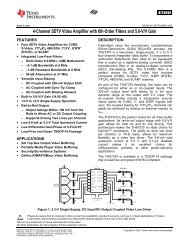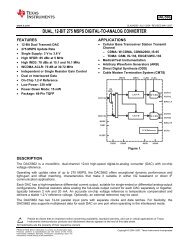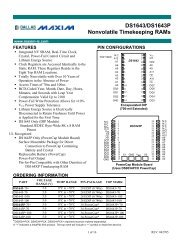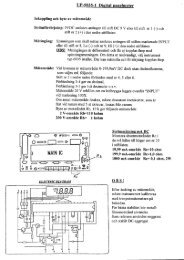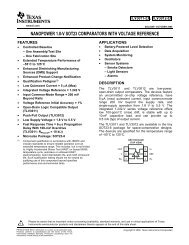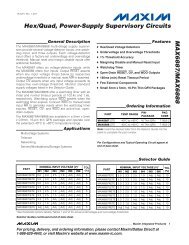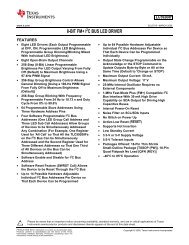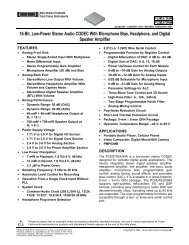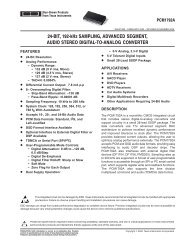Single-Chip Low Power RF Transceiver for Narrowband Systems ...
Single-Chip Low Power RF Transceiver for Narrowband Systems ...
Single-Chip Low Power RF Transceiver for Narrowband Systems ...
You also want an ePaper? Increase the reach of your titles
YUMPU automatically turns print PDFs into web optimized ePapers that Google loves.
12.5. RSSI<br />
CC1021 has a built-in RSSI (Received<br />
Signal Strength Indicator) giving a digital<br />
value that can be read <strong>for</strong>m the RSSI<br />
register. The RSSI reading must be offset<br />
and adjusted <strong>for</strong> VGA gain setting<br />
(VGA_SETTING[4:0] in the VGA3<br />
register).<br />
The digital RSSI value is ranging from 0 to<br />
106 (7 bits).<br />
The RSSI reading is a logarithmic<br />
measure of the average voltage amplitude<br />
after the digital filter in the digital part of<br />
the IF chain:<br />
RSSI = 4 log2(signal amplitude)<br />
The relative power is then given by RSSI x<br />
1.5 dB in a logarithmic scale.<br />
The number of samples used to calculate<br />
the average signal amplitude is controlled<br />
by AGC_AVG[1:0] in the VGA2 register.<br />
The RSSI update rate is given by:<br />
f<br />
filter _ clock<br />
RSSI = AGC _ AVG<br />
2<br />
f<br />
[ 1:<br />
0]<br />
+ 1<br />
where AGC_AVG[1:0] is set in the VGA2<br />
register and filt = 2⋅<br />
ChBW .<br />
f er _ clock<br />
Maximum VGA gain is programmed by the<br />
VGA_SETTING[4:0] bits. The VGA gain is<br />
programmed in approximately 3 dB/LSB.<br />
The RSSI measurement can be referred to<br />
the power (absolute value) at the <strong>RF</strong>_IN<br />
pin<br />
by using the following equation:<br />
CC1021<br />
P = 1.5·RSSI - 3·VGA_SETTING -<br />
RSSI_Offset [dBm]<br />
The RSSI_Offset depends on the channel<br />
filter bandwidth used due to different VGA<br />
settings. Figure 14 and Figure 15 show<br />
typical plots of RSSI reading as a function<br />
of input power <strong>for</strong> different channel filter<br />
bandwidths. Refer to Application Note<br />
AN030 CC1020/1021 RSSI <strong>for</strong> further<br />
details.<br />
The following method can be used to<br />
calculate the power P in dBm from the<br />
RSSI readout values in Figure 14 and<br />
Figure 15:<br />
P = 1.5·[RSSI – RSSI_ref] + P_ref<br />
where P is the output power in dBm <strong>for</strong> the<br />
current RSSI readout value. RSSI_ref is<br />
the RSSI readout value taken from<br />
Figure 14 or Figure 15 <strong>for</strong> an input power<br />
level of P_ref. Note that the RSSI readings<br />
in decimal value changes <strong>for</strong> different<br />
channel filter bandwidths.<br />
The analog filter has a finite dynamic<br />
range and is the reason why the RSSI<br />
reading is saturated at lower channel filter<br />
bandwidths. Higher channel filter<br />
bandwidths are typically used <strong>for</strong> high<br />
frequency deviation and data rates. The<br />
analog filter bandwidth is about 160 kHz<br />
and is bypassed <strong>for</strong> high frequency<br />
deviation and data rates and is the reason<br />
why the RSSI reading is not saturated <strong>for</strong><br />
153.6 kHz and 307.2 kHz channel filter<br />
bandwidths in Figure 14 and Figure 15.<br />
SWRS045B Page 33 of 89


